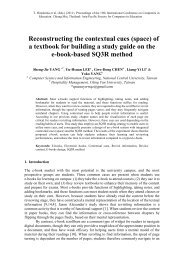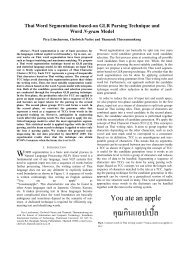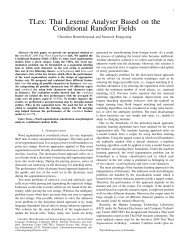ab initio and density functional studies of polythiophene ... - Nectec
ab initio and density functional studies of polythiophene ... - Nectec
ab initio and density functional studies of polythiophene ... - Nectec
Create successful ePaper yourself
Turn your PDF publications into a flip-book with our unique Google optimized e-Paper software.
NECTEC Technical Journal, Vol. II, No. 9 216<strong>functional</strong> which was proposed by Becke [11a] in 1988 usinga gradient-corrected correlation <strong>functional</strong> <strong>of</strong> Lee, Yang <strong>and</strong>Parr [11b, 11c] was employed. Hybrid <strong>functional</strong> are alsoused, the Becke’s three-parameter <strong>functional</strong> (B3) [11d]which defines the exchange <strong>functional</strong> as the linearcombination <strong>of</strong> Hartree-Fock, local <strong>and</strong> gradient-correctedexchange terms. The B3 hybrid <strong>functional</strong> was used incombination with the correlation <strong>functional</strong>s <strong>of</strong> Lee, Yang<strong>and</strong> Parr <strong>and</strong> non-local correlation expression provided by thePerdew 86 (P86) [11e].The type <strong>of</strong> basis set is that <strong>of</strong> Stephens/Basch/Krauss ECPsplit valence (CEP-31G), augmented with polarizationfunctions on heavy atoms (CEP-31G*), diffused function(CEP-31+G) <strong>and</strong> polarized functions (6-31G**). These basissets were employed because some previous calculations [6]suggest that their results are in good agreement with theexperimental values <strong>of</strong> the energy b<strong>and</strong> gap <strong>of</strong> differentpolymeric system.The vibrational frequency calculations were carried out tocharacterize the stationary points. Symmetry constraintswere applied whenever possible.All calculations were performed using the Gausian ’94 [9]<strong>and</strong> GAMESS [10] suites <strong>of</strong> quantum chemistry programsrunning under Beowulf cluster, SunSparc station, <strong>and</strong> DECalpha machines.3. Results <strong>and</strong> Discussion3.1 GeometriesThe optimized results using hybrid DFT <strong>functional</strong>(B3LYP/CEP-31G*) are shown in Figure 2. This is thest<strong>ab</strong>le geometry <strong>of</strong> thiophene monomer <strong>and</strong> dimer. With theHF/6-31G* <strong>and</strong> B3LYP/CEP-31G*, the bond length are up to±0.025Å <strong>and</strong> ±0.046Å, respectively when compared toexperimental values. The bond angles agree very closely (towithin ±0.33 o ) with experiment. Pure <strong>and</strong> hybrid <strong>functional</strong>sgeometries are almost identical. Compared to HF theory,DFT yields longer C=C double bonds. Thus, at HF, π-electrons is more localized. This is most likely due to theneglect <strong>of</strong> electron correlation. For geometry calculations,HF revealed more accurate estimates, indicating that it maynot be necessary to perform DFT calculations to obtain goodgeometries in this case. Complete documentation <strong>of</strong>geometries is listed in T<strong>ab</strong>le 1.3.2 Energy B<strong>and</strong> GapsSpectroscopic data for organic π-systems are usuallydetermined either in solution or in the solid state (crystal orthin film). Since our calculations are for isolated molecules inthe gas phase, we have attempted to compare our calculationto experimental results in solution.T<strong>ab</strong>le 2 summarizes the energy b<strong>and</strong> gap <strong>of</strong> intrinsicthiophene monomers <strong>and</strong> dimers at HF, BLYP, B3LYP <strong>and</strong>B3P86 with various combinations <strong>of</strong> basis sets. As expected,the RHF energy b<strong>and</strong> gap <strong>of</strong> intrinsic thiophene oligomersoverestimates the excitation energy because <strong>of</strong> the <strong>ab</strong>sence <strong>of</strong>correlation contribution [16]. Little improvement <strong>of</strong> theenergy b<strong>and</strong> gap is obtained in applying a higher level basisset; the <strong>ab</strong>solute error is 5.51-6.10 eV. It is expected that thepercent error decrease with increasing length <strong>of</strong> polymers atthis level <strong>of</strong> theory [9]. The pure DFT <strong>functional</strong> (BLYP)underestimate the energy b<strong>and</strong> gap by up to 1.77 eVcompared to the experimental excitation energy. Hybrid DFTmethod (B3LYP <strong>and</strong> B3P86) yielded HOMO-LUMO energydifference which are in good agreement with the experiment.The DFT (B3LYP <strong>and</strong> B3P86) energy b<strong>and</strong> gaps forthiophene dimer give an error <strong>of</strong> only up to 0.22 eV <strong>and</strong> 0.17eV, respectively. The two hybrid <strong>functional</strong>s lead to almostidentical results. Applying more comprehensive basis ddidnot significantly improve the energy b<strong>and</strong> gap <strong>of</strong> thiopheneoligomer. This study shows that by using hybrid DFT<strong>functional</strong>s, a substantial improvement in the excitationenergy can be obtained. The same observation was alsoreported previously by other workers [1, 2] using differentpolymeric system.Figure 2. Structures <strong>of</strong> thiophene (a) monomer (b) dimer. Calculated bond distances are given in angstrom (Å) atB3LYP/CEP-31G*.
















